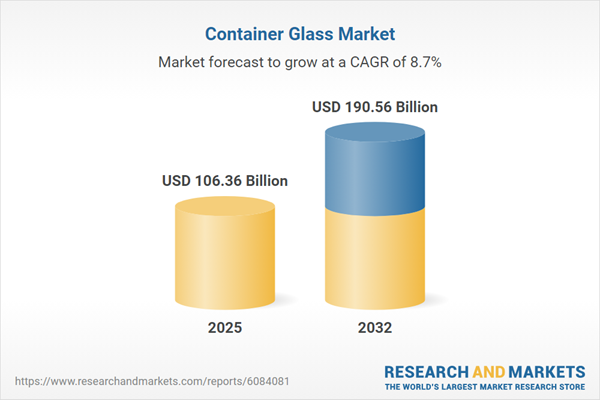Speak directly to the analyst to clarify any post sales queries you may have.
The container glass market is evolving rapidly as businesses adapt to shifting regulatory landscapes and rising expectations for sustainable, high-performance packaging. Senior decision-makers must navigate industry transformation and drive resilient strategies in this competitive environment.
Market Snapshot: Container Glass Market Overview
The global container glass market is estimated at USD 97.84 billion in 2024 and is projected to reach USD 106.36 billion in 2025, with a CAGR of 8.68%. Forecasts indicate an upward trajectory, with market value anticipated to achieve USD 190.56 billion by 2032. This continued expansion is propelled by global packaging demands, the need for environmentally responsible solutions, and ongoing advancements in manufacturing technologies that improve efficiency and quality.
Scope & Segmentation of the Container Glass Market
This report delivers an in-depth analysis, segmenting the container glass market by product types, materials, manufacturing processes, end-use applications, and regions to support targeted business strategies.
- Material Types: The market comprises borosilicate glass, lead glass, and soda-lime glass. Each material offers differing properties, from thermal resistance to clarity, supporting diverse sector needs.
- Product Types: In addition to bottles used for alcohol, beverages, and pharmaceuticals, the segment covers jars, vials, and other containers that enhance shelf presence and product differentiation.
- Manufacturing Processes: Industry participants utilize blow & blow, narrow neck press & blow, and press & blow methods, enabling flexible production runs and optimization for various end-use requirements.
- End Use Applications: Container glass serves chemicals, cosmetics & personal care, food & beverage (including both alcoholic and non-alcoholic segments), and pharmaceuticals, aligning with safety and performance needs.
- Regional Analysis: Coverage spans Americas (including United States, Canada, Brazil), Europe, Middle East & Africa (with key markets like Germany, UAE, South Africa), and Asia-Pacific (including China, India, Australia), reflecting distinct regulatory approaches and market dynamics.
- Leading Companies: Notable players include Owens-Illinois, Inc., Ardagh Group S.A., Verallia S.A., Vitro S.A.B. de C.V., Vetropack Holding AG, SGD S.A., Piramal Glass Limited, Gerresheimer AG, Consol Glass (Pty) Ltd, and Beatson Clark Limited. These firms prioritize scale, supply chain coordination, and technological leadership.
Key Takeaways: Strategic Insights for Senior Decision-Makers
- Manufacturers are leveraging digital controls and integrating recycled content to modernize processes, curtail environmental impact, and address stricter compliance requirements.
- Premiumization and personalization are influencing packaging design, compelling brands to develop differentiated, high-appeal containers, boosting brand visibility and customer engagement.
- Cross-sector collaboration is strengthening closed-loop recycling, enriching the supply of sustainable glass materials, and ensuring alignment with circular economy principles.
- Innovation efforts are expanding the range of products targeting premium beverages, specialized pharmaceuticals, and advanced coatings, fostering brand loyalty and market competitiveness.
- Region-specific strategic planning is crucial, with organizations tailoring approaches to varying infrastructure, local consumer preferences, and shifting regulatory environments across global markets.
- Supply chain resilience is advanced by investing in regional supplier networks and digital inventory systems, promoting consistent operations despite geopolitical or logistical disruptions.
Tariff Impact: Navigating U.S. 2025 Regulatory Changes
Revised U.S. tariffs on imported container glass and associated parts are driving supply chain adjustments and cost reassessments. Companies are focusing on domestic production, vertical integration, and alternative procurement models to secure supply and offset higher expenses. Downstream stakeholders are optimizing packaging design, emphasizing value-added features and premiumization to counterbalance increased costs. Greater emphasis on export market diversification and regional supply chain partnerships is bolstering resilience to future trade fluctuation risks.
Methodology & Data Sources
The analysis is grounded in primary research through executive interviews and manufacturing site visits, complemented by secondary sources such as trade publications, technical standards, and regulatory documentation. Cross-verification using advanced statistical approaches ensures robust sector and segment insights for container glass stakeholders.
Why This Report Matters: Senior Leadership Outcomes
- Enables informed investment decisions with actionable, region-specific intelligence on pricing models, procurement opportunities, and operational efficiency within the container glass industry.
- Supports resilience and sustainability planning through evidence-driven analysis on evolving regulations and closed-loop supply chain models.
- Guides leadership in allocating resources and developing innovation pipelines for high-growth, premium, or niche packaging segments.
Conclusion
Actionable insights from this report empower senior leaders to realign strategies with evolving sustainability standards, embrace digital transformation, and proactively capture opportunities within the fast-changing container glass sector.
Table of Contents
3. Executive Summary
4. Market Overview
7. Cumulative Impact of Artificial Intelligence 2025
Companies Mentioned
The companies profiled in this Container Glass market report include:- Owens-Illinois, Inc.
- Ardagh Group S.A.
- Verallia S.A.
- Vitro, S.A.B. de C.V.
- Vetropack Holding AG
- SGD S.A.
- Piramal Glass Limited
- Gerresheimer AG
- Consol Glass (Pty) Ltd
- Beatson Clark Limited
Table Information
| Report Attribute | Details |
|---|---|
| No. of Pages | 194 |
| Published | October 2025 |
| Forecast Period | 2025 - 2032 |
| Estimated Market Value ( USD | $ 106.36 Billion |
| Forecasted Market Value ( USD | $ 190.56 Billion |
| Compound Annual Growth Rate | 8.6% |
| Regions Covered | Global |
| No. of Companies Mentioned | 11 |









